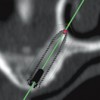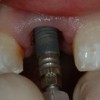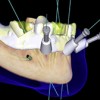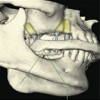This program describes the arrangement of anatomic (30 degree) and semi-anatomic teeth to achieve bilateral balanced occlusion. Bilateral balance is accomplished by achieving solid centric and arranging the denture teeth to accommodate for the curve of Wilson and the Curve of Spee.
Complete Dentures – Occlusal Schemes – Anatomic and Semiamatomic Occlusion — Course Transcript
- 1. 17. Occlusal Schemes – Anatomic and Semi-anatomic John Beumer III, DDS, MS and Michael Hamada DDS Division of Advanced Prosthodontics, Biomaterials and Hospital Dentistry UCLA School of Dentistry This program of instruction is protected by copyright ©. No portion of this program of instruction may be reproduced, recorded or transferred by any means electronic, digital, photographic, mechanical etc., or by any information storage or retrieval system, without prior permission.
- 2. Semi-anatomic Denture Teeth Begin by positioning the appropriate protrusive insert, and check to ensure that the incisal guide pin is set at zero and in contact with the incisal guide table. Protrusive insert Protrusive Inserts Zero setting
- 3. Background – Balanced occlusion Our objective in setting anatomic or semi-anatomic posterior teeth is to create a balanced occlusion. We wish to insure that all the posterior teeth as well as the anterior teeth maintain contact in lateral excursions. To ensure bilateral balance we place an anterior-posterior curve in the arch, called a compensating curve, which is analogous to the curve of Spee in natural dentition. In addition , we place a curve from side to side, the so called curve of Wilson. Semi-anatomic Denture Teeth
- 4. Mark the casts indicating midline, crest of the ridge, and the retromolar pad . These landmarks will be used to check your denture setup. Maxilla Midline Anterior land Mandible Ridge Retromolar pad Cast Landmarks
- 5. Anterior land Cast Landmarks – Maxilla Midline Incisive papilla
- 6. Lines indicating the crest of the ridge Cast Landmarks -Mandible Midpoint of retromolar pad Land Mark on land indicating the midpoint of the retromolar pad
- 7. As previously mentioned (13c, 1a), the wax rim is ideally contoured on the patient and used to mount the upper cast with a facebow transfer record. When the lower cast is mounted on the articulator with a centric relation record the plane of occlusion is readily seen. The three landmarks used to identify the plane of occlusion are: The midpoint of the retromolar pads bilaterally as previously marked on the mandibular cast. The incisal edge of the maxillary central incisors Setting the Maxillary Anterior Teeth
- 8. To set the remaining maxillary anterior teeth a clear glass or plastic slab is positioned on the mandibular record base to represent the plane of occlusion. When setting anatomic posterior teeth we recommend setting the maxillary posterior teeth before the mandibular posterior teeth. To aid in positioning the maxillary teeth, a line is inscribed on the slab indicating the crest of the mandibular ridge. Setting the Maxillary Anterior Teeth Mark indicating midpoint of the retromolar pad
- 9. Setting the Maxillary Anterior Teeth These two lines, inscribed on the plastic plane, indicate the crest of the alveolar ridge. These lines will be used to position the maxillary posterior denture teeth to insure that the mandibular posterior teeth are centered over the ridge. The lingual cusp tips of the posterior maxillary teeth should contact these lines. Lines indicating the crest of the ridge
- 10. Setting the Maxillary Anterior Teeth Soften some baseplate wax and attach some to the ridge lap portion of the other maxillary central incisor and attach it to the record base as shown. Set the lateral incisors and cuspids as shown previously (Section 13c, 1a Lingualized occlusion).
- 11. Setting the Maxillary Anterior Teeth Note the angulations of the anterior teeth in relation to the occlusal plane when viewed in profile. Occlusal plane
- 12. Setting the Maxillary Anterior Teeth “ Toed-in” Position Note how the cervical and incisal edges of the cuspid are aligned vertically (yellow line). The facial surface of the cuspid however, is canted inward and appears “toed in” (red line) due to the prominence of the cervical area of the tooth (yellow arrow). The centrals and laterals are inclined slightly towards the distal.
- 13. The long axis of the premolars should be perpendicular to the occlusal plane and the buccal and lingual cusp tips should touch the occlusal plane. Arranging the premolars in this way insures that the adjacent marginal ridges will be on the same level. This is an important factor when setting the opposing premolars. Setting the Maxillary Posterior Teeth Occlusal plane
- 14. The Maxillary Premolars Setting the Maxillary Posterior Teeth Both the buccal and lingual cusp tips of the maxillary premolars should contact the plane of occlusion. The lingual cusp tips should also contact the line inscribed on the plastic plane indicating the crest of the mandibular ridge. This will ensure that when the opposing mandibular denture teeth are properly positioned and in occlusion, their central fossae will be centered over the mandibular ridge.
- 15. Setting the Maxillary Posterior Teeth The curve of Wilson and the curve of Spee begin in the molar region. The mesial lingual cusp tip of the 1 st molar contacts the occlusal plane but the buccal cusp tips and the distal lingual cusp are elevated about .5mm off the occlusal plane (yellow line) . The Maxillary 1 st Molar
- 16. The Maxillary 2 nd Molar Setting the Maxillary Posterior Teeth The set up viewed in profile. Note that the mesial lingual cusp tip touches the plane of occlusion along with the buccal and lingual cusps of the premolars. The curve of Spee begins at the 1 st molar.
- 17. The Maxillary 2 nd Molar Setting the Maxillary Posterior Teeth The curve of Spee is continued by elevating the 2 nd molar off the plane of occlusion as shown. The 2 nd molar is elevated to an even greater degree than the 1 st molar, about 15 degrees in the average patient. When viewed from the distal it is set, like the 1 st molar, with a slight curve of Wilson. Occlusal plane
- 18. Setting the Mandibular Posterior Teeth Note that with this particular posterior tooth form, the mandibular cusps tips are designed to engage the embrasures of the opposing maxillary teeth. This true of almost all anatomic tooth forms designed for bilateral balance except the Ivoclar Ortholingual. Completed set up Centric
- 19. The Mandibular 1st Molar Setting the Mandibular Posterior Teeth Begin by positioning the mandibular 1 st molar. The mesial buccal cusp tip should engage the embrasure between the 1 st molar and 2 nd premolar. Therefore adjacent marginal ridges of the maxillary premolar and molar must be at the same level for the lower molar to properly engage them.
- 20. The Mandibular 1st Molar Setting the Mandibular Posterior Teeth Check the relationship from the lingual side. Make sure that the maxillary lingual cusp tips engage the the central fossa of the mandibular molar.
- 21. The Mandibular 1st Molar Setting the Mandibular Posterior Teeth Using a clear plastic ruler and the marks made on the cast check to insure that the 1 st molar is perfectly centered over the ridge. Make sure the central fossa of the molar is properly aligned over the ridge. If the central fossa is either buccal or lingual to the ridge make the appropriate adjustments. It is apparent that the molar is positioned too far to the buccal.
- 22. The Mandibular 1st Molar Setting the Mandibular Posterior Teeth Note the alignment of the central fossa.The molar is positioned too far to the buccal and should be moved towards to the lingual . If the remaining mandibular posterior teeth are arranged on this line the denture will be prone to tipping and its stability will be impaired. Line indicating the crest of the ridge After repositioning this tooth focus your attention on the maxillary posterior teeth and reposition them lingually so that the maxillary 1 st molar and 2 nd premolar properly occlude with the mandibular 1 st molar. Do not forget to move the 1 st premolar as well.
- 23. The Mandibular 1st Molar Setting the Mandibular Posterior Teeth The molar is twisted and positioned too far to the lingual. If the remaining posterior mandibular teeth are arranged along this line the space for the tongue will likely be insufficient. The molar must be moved slightly to the buccal and twisted clockwise so that the central fossa is parallel to the ridge line. Line indicating the crest of the ridge After repositioning this tooth the posterior maxillary teeth should be moved to the buccal so that they properly occlude with the mandibular molar and permit positioning the remaining mandibular posterior teeth over the ridge.
- 24. The Mandibular Premolars – Centric Setting the Mandibular Posterior Teeth Position the mandibular premolars. The buccal cusp of the 2 nd premolar should occlude with the the adjacent marginal ridges of the maxillary 1 st and 2 nd premolars.
- 25. The Mandibular Premolars – Centric Setting the Mandibular Posterior Teeth The buccal cusp of the mandibular 1 st premolar should engage the mesial marginal ridge of the opposing 1 st premolar. There should be a space between the 1 st premolar and the cuspid.
- 26. The Mandibular Premolars – Centric Setting the Mandibular Posterior Teeth Verify that the premolars are in solid centric occlusion. If lingual centric contacts are lacking, contacts in balancing position will be lacking.
- 27. The Mandibular Premolars – Working Setting the Mandibular Posterior Teeth When there is a lack of working side contacts at this stage of the setup check for the following discrepancies in the following order: Verify buccal centric Check for balancing interferences on the opposite side Slightly increase the curve of Wilson without compromising lingual centric
- 28. The Mandibular Premolars – Working Complete Denture Occlusion During the lateral excursion into working, with this cusp form, when the teeth are properly arranged, there should be no lingual cusp contacts between the maxillary and mandibular teeth.
- 29. The Mandibular Molars – Balancing Setting the Mandibular Posterior Teeth When you lack balancing side contacts at this stage of the setup, check for the following discrepancies in the following order. Verify lingual centric Check for working interferences on the opposite side
- 30. The Mandibular 2 nd Molar – Centric Setting the Posterior Mandibular Teeth Position the 2 nd molars in centric. Inappropriate positioning and angulation of the 2 nd molars can cause significant discrepancies in working, balancing and protrusive, and so you again must check the excursions carefully.
- 31. The Mandibular 2 nd Molar – Centric Setting the Mandibular Posterior Teeth Check lingual centric. Make sure that the lingual cusps of the maxillary 2 nd molar properly occludes with the central fossa of the mandibular 2 nd molar as shown.
- 32. Verify contacts in working excursions Setting the Mandibular Posterior Teeth Lack of working side contacts may be the result of: Poor buccal centric Insufficient curve of Wilson Working interferences in the 2 nd molar region Balancing interferences on the opposite side * Check these in the order cited .
- 33. Verify contacts in during balancing excursion Setting the Mandibular Posterior Teeth Lack of balancing side contacts may be the result of: Poor lingual centric Working interferences on the opposite side, particularly in the 2 nd molar region
- 34. The Central Incisors Setting the Mandibular Anterior Teeth Begin by setting the central incisors. The mesial surfaces should be on the midline.
- 35. Setting the Mandibular Central Incisors In most patients the labial surface of the mandibular incisors should be roughly perpendicular to the occlusal plane. Occlusal plane The Central Incisors
- 36. Determining the Amount of Vertical and Horizontal Overlap Setting the Mandibular Anterior Teeth The articulator is placed in the working and protrusive position, and the position of the central incisors adjusted to permit passive contact during lateral excursions. Working Protrusive
- 37. Setting the Mandibular Anterior Teeth Horizontal overlap This practice will idealize the amount of horizontal and vertical overlap and ensure that anterior guidance is not introduced into the setup. Horizontal overlap Vertical overlap
- 38. The Lateral Incisors and the Cuspids Setting the Mandibular Anterior Teeth Position the lateral incisors and cuspids in the same fashion as the central incisors. Take care not to introduce anterior guidance into the set up. The anterior teeth should be in only passive contact during lateral excursions. Working Protrusive
- 39. The Lateral Incisors and the Cuspids Setting the Mandibular Anterior Teeth Upon completion, the amount of vertical and horizontal overlap will be idealized and anterior guidance has not been introduced into the setup. Bilateral balance has been maintained.
- 40. Semi-anatomic Denture Teeth Check to ensure you have retained appropriate contacts in working, balancing and protrusive. Balancing Working Protrusive Completed set up Centric
- 41. Anatomic Denture Teeth (30 degree)
- 42. Anatomic Denture Teeth (30 degree) These teeth are arranged in the same fashion as the semi-anatomic teeth shown previously. Use the same sequence of steps as we have just shown.
- 43. Anatomic Denture Teeth (30 degree) Begin by positioning the appropriate protrusive insert, and check to ensure that the incisal guide pin is set at zero and in contact with the incisal guide table. Protrusive insert Protrusive Inserts Zero setting
- 44. Setting Anatomic Teeth (30 degree) When you are finished check to see that the posterior teeth are on plane and the posterior teeth centered over the mandibular ridge. Make corrections as necessary.
- 45. Setting Anatomic Teeth (30 degree) Check buccal and lingual centric.
- 46. Setting Anatomic Teeth (30 degree) Check to ensure you have retained appropriate contacts in working, balancing and protrusive. Balancing Protrusive Working
- 47. Trouble shooting Anatomic and Semi-anatomic Denture Teeth Lack of working side contacts Verify buccal centric. Restore centric contacts as necessary. Increase the curve of Wilson Eliminate any anterior guidance present on the working side. Check for balancing interferences on the opposite side and make adjustments as necessary.
- 48. Trouble shooting Anatomic and Semi-anatomic Denture Teeth Lack of balancing side contacts Verify lingual centric. Restore missing contacts as necessary. Eliminate any anterior guidance present on the opposite or working side. Check for working interferences on the opposite side particularly in the 2 nd molar region.


 Prosthodontic Procedures and Complications
Prosthodontic Procedures and Complications
 Single Tooth Defects in Posterior Quadrants
Single Tooth Defects in Posterior Quadrants
 Computer Guided Treatment Planning and Surgery
Computer Guided Treatment Planning and Surgery
 Angled Implants
Angled Implants
